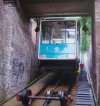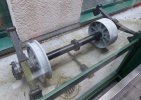-
Our booking engine at tickets.railforums.co.uk (powered by TrainSplit) helps support the running of the forum with every ticket purchase! Find out more and ask any questions/give us feedback in this thread!
You are using an out of date browser. It may not display this or other websites correctly.
You should upgrade or use an alternative browser.
You should upgrade or use an alternative browser.
Wheel flange
- Thread starter 158801
- Start date
- Status
- Not open for further replies.
Sponsor Post - registered members do not see these adverts; click here to register, or click here to log in
R
RailUK Forums
You are aware that wheels have carefully designed profiles and that rails in most cases are very gently angled inwards? Either of which mean it is completely bonkers from engineer perspective not to have the flanges on the inside.Is there a good reason why the flange is on the inside of a train wheel?
What are the disadvantages of having it on the outside?
Then if you understand how flanges work and how the wheel go round tight corners not having them on the inside is also a non starter.
The alternative to flanges on wheels is flanges on the outside of the rail but they moved away from that ~190years ago.
As it can't realistically be done then "disadvantages" are bit moot....
edwin_m
Veteran Member
As mentioned above, the tread of the railway wheel is slightly "coned" so the diameter nearer the flange is larger. On moderate curves the axle can move slightly outwards so that the difference in diameter compensates the greater distance the wheel has to run on the outer rail. It also tends to keep the wheel running on its tread, so that flange contact only occurs on tighter curves where the difference in length between the two rails is too much to overcome. This reduces wear and noise compared with the situation where one wheel or other is slightly slipping or in the flange is constantly rubbing on the rail.
If the flange was on the outside and the coning was the other way round the opposite effect would happen, one wheel would be slipping on any sort of curve, and the wheelset would probably run off-centre with one flange constantly wearing against its rail. You could I suppose consider a coned tread as now with the flange on the outer (smaller diameter) end, but that would be creating a sharp transition in the profile which would be perfect for initiating stress cracks.
If the flange was on the outside and the coning was the other way round the opposite effect would happen, one wheel would be slipping on any sort of curve, and the wheelset would probably run off-centre with one flange constantly wearing against its rail. You could I suppose consider a coned tread as now with the flange on the outer (smaller diameter) end, but that would be creating a sharp transition in the profile which would be perfect for initiating stress cracks.
100andthirty
Member
For the sake of completeness, a very small number of cable hauled railways - funiculars have wheelsets with a flange on the inside and outside of one wheel and no flanges on the other. on funiculars with two vehicles balanced via the rope, this system allows the cars on a single track to pass at a passing loop without having to have any moving parts in the points. The wheel with flanges is on the side of the car corresponding to which loop it follows. in the photos, the wheelset removed from the vehicle would follow the right hand loop when looking uphill - I hope that makes sense. As you can see, on these wheelsets, the tread is flat, not coned. At funicular speeds this is unimportant!
The photos are photos of a museum display but I hope they're clear enough.
The photos are photos of a museum display but I hope they're clear enough.
Attachments
pdeaves
Established Member
There was at, I think, the NRM (might have been somewhere like STEAM museum) a hands-on demonstration/toy of exactly this. Put the different foam wheel sets on the rails and see which performs best.As mentioned above, the tread of the railway wheel is slightly "coned" so the diameter nearer the flange is larger. On moderate curves the axle can move slightly outwards so that the difference in diameter compensates the greater distance the wheel has to run on the outer rail. It also tends to keep the wheel running on its tread, so that flange contact only occurs on tighter curves where the difference in length between the two rails is too much to overcome. This reduces wear and noise compared with the situation where one wheel or other is slightly slipping or in the flange is constantly rubbing on the rail.
If the flange was on the outside and the coning was the other way round the opposite effect would happen, one wheel would be slipping on any sort of curve, and the wheelset would probably run off-centre with one flange constantly wearing against its rail. You could I suppose consider a coned tread as now with the flange on the outer (smaller diameter) end, but that would be creating a sharp transition in the profile which would be perfect for initiating stress cracks.
It is easier to give a nice smooth(er) transition at points with inside flanges, too.
colchesterken
Member
- Joined
- 12 Oct 2010
- Messages
- 764
Just a thought, anyone know the gauge of the flange, looks like they are about an inch inwards from he rail
edwin_m
Veteran Member
There's definitely a standard for this, particularly the "back to back" of flanges, but I don't know the dimension offhand. If this is wrong then trains may derail on points.Just a thought, anyone know the gauge of the flange, looks like they are about an inch inwards from he rail
The reason for my question popped into my head after recently watching "Ian Hislop, the trains that changed the world".
There are pictures of very old steam trains that had flanges on the inside. The benefits of this must have been apparent very early on in the history of the railways.
Having cone shaped wheels seems to be a more modern invention
There are pictures of very old steam trains that had flanges on the inside. The benefits of this must have been apparent very early on in the history of the railways.
Having cone shaped wheels seems to be a more modern invention
swt_passenger
Veteran Member
- Joined
- 7 Apr 2010
- Messages
- 31,382
I once found an explanation which mentioned George Stephenson had investigated coned wheels in the 1820s... I don’t think they’re that “modern”...The reason for my question popped into my head after recently watching "Ian Hislop, the trains that changed the world".
There are pictures of very old steam trains that had flanges on the inside. The benefits of this must have been apparent very early on in the history of the railways.
Having cone shaped wheels seems to be a more modern invention
hexagon789
Veteran Member
About as 'modern' as Stephenson's RocketHaving cone shaped wheels seems to be a more modern invention
There are a few railways that used non-conical wheelsets for a significant period though, as well as a few that do today
Ah, slightly older than I thought then. That makes sense though because I would've expected him to try a different approach after the issues with the rails on the Stockton & Darlington.I once found an explanation which mentioned George Stephenson had investigated coned wheels in the 1820s... I don’t think they’re that “modern”...
I believe it is 32mm so when that is doubled for both wheels and the 1360mm length of the axle it totals 1424mm which is the tightest track gauge allowed on NR infrastructure.Just a thought, anyone know the gauge of the flange, looks like they are about an inch inwards from he rail
edwin_m
Veteran Member
The Bay Area Rapid Transit in the States was designed by non-railway people who didn't appreciate the benefits of coned wheels, as well as using a track gauge not found anywhere nearer than Argentina, and has been suffering in maintenance costs ever since. At least they didn't put the flanges on the outside too.About as 'modern' as Stephenson's Rocket
There are a few railways that used non-conical wheelsets for a significant period though, as well as a few that do today
Ah, slightly older than I thought then. That makes sense though because I would've expected him to try a different approach after the issues with the rails on the Stockton & Darlington.
Some tramways (Hull was one I think) used to have centre flange wheels running on rails with a central groove. This allowed smoother running on points because the wheel didn't drop into the flange gap, though the same is usually achieved on tramways by raising the bottom of the groove so the trams run on flange tips through the crossings.
hexagon789
Veteran Member
Queensland Railways also used flat wheels I believe, for quite some time as well?The Bay Area Rapid Transit in the States was designed by non-railway people who didn't appreciate the benefits of coned wheels, as well as using a track gauge not found anywhere nearer than Argentina, and has been suffering in maintenance costs ever since. At least they didn't put the flanges on the outside too.
Some tramways (Hull was one I think) used to have centre flange wheels running on rails with a central groove. This allowed smoother running on points because the wheel didn't drop into the flange gap, though the same is usually achieved on tramways by raising the bottom of the groove so the trams run on flange tips through the crossings.
furnessvale
Established Member
- Joined
- 14 Jul 2015
- Messages
- 4,576
I'm trying to get my head around the redesign of points and crossings to accommodate external flanges!Is there a good reason why the flange is on the inside of a train wheel?
What are the disadvantages of having it on the outside?
- Status
- Not open for further replies.



